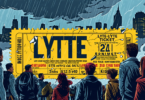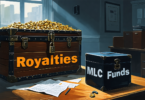A new way for artists to retain more revenue, or will record labels co-opt the NFT movement first?
Updated June 1, 2021 • 6 min read
Check out MASHENE drop yesterday: “Along The Hopi Trail” The Greatest Music Ever Written for a FORD BRONCO commercial. Soon to be released on a blockchain.
Summary
In an industry where entities like record labels and streaming services take a large cut of profits from musical artists, non-fungible tokens (NFTs) are being increasingly adopted as a new independent revenue stream for musical artists.
Non-fungible tokens (NFTs) present an opportunity for creators to capture value for their work in unprecedented ways. Whether it’s the art world or the music industry, creative industries are saddled with middlemen and intermediaries that siphon huge percentages of profits from artists in exchange for distribution, marketing, or accessing scale. Whether it’s a fine art auction house or a record label, NFTs present a unique opportunity for an antiquated system to be completely re-wired to be more equitable, not just for creators, but consumers and fans as well. That’s why NFTs have achieved such remarkable notoriety in such a short period of time.
NFT-enabled creative works make use of automated smart contracts (automatically executing programs on the blockchain) that authenticate a work and track its provenance and value as it changes hands — a process which, prior to blockchain, was laborious, slow, and error-prone. Original artists are now able to keep the majority of profits when selling their work the first time — current standards see NFT artists retain approximately 80-90% of sales — in addition to royalties represented by a percentage of every subsequent sale in the future. These processes are cryptographically secured and guaranteed by smart contracts, which eradicate the need for costly middlemen and gatekeepers. With the ability to put more money in the hands of musicians upon the initial release of an album or song — and the ability to guarantee the payment of predetermined blockchain music royalties from that point on — NFTs make a strong case for reinventing the music industry’s dominant payment model altogether.
The Antiquated Music Industry Model vs. NFT Marketplaces
Just like blockchain technology and cryptocurrency are applying the disruptive ethos of decentralization to the traditional finance sector, the music industry is an industry ripe for a radical reorganization of value capture. Music is a highly centralized industry. Three major record labels — Sony, Universal, and Warner — control the lion’s share of the music industry with an estimated 66% to 80% of market share, a figure that varies slightly from year to year.
Unfortunately for many creators, even many “indie” record labels are owned by a parent company tied to one of these three giants in some way or another. What this means for musical artists is that there aren’t many avenues for generating independent revenue, even the ones that are traditionally labeled as “independent.”
With the digitization of music that began with Napster and led to the ubiquitous growth of Spotify, record sales have taken a backseat to streaming services, which are also notorious for hoarding a large portion of the revenue so that very little makes its way to the original artist. With most of the revenue siphoned away by labels and streaming platforms, it is estimated that most musical artists generate up to 75% of their income from touring and doing live shows.
The unfortunate reality is that musical artists have been hurting — both with the traditional industry model and when circumstances limit their ability to host live events — and many are eager to explore new revenue streams. NFTs present an opportunity for artists to deliver their music directly to consumers without the need for a third-party intermediary. Many artists maintain hope that NFTs will provide a new opportunity for artists to be paid equitably for their work through blockchain music licensing and royalties. And while NFT music releases likely won’t replace the role of record labels altogether, they will likely help artists diversify and increase their revenue streams.
How Do Audio NFTs Work?
NFTs thus far are most often associated with an image or video. This still holds true in most cases for musical artists as well. Most musicians experimenting with NFTs thus far have released an image or video set to an audio pairing that loops in tandem. You can think of the image or video pairing as an album cover of sorts; it’s an original image that is inextricably linked to the music.
Even this early iteration of music NFTs has opened up a whole new opportunity for musical and visual artists to work together to create unique collaborations and further the creative process to include mediums that did not exist before. Many musical artists seek out visual artists as collaborators to create their NFTs. Each NFT can be programmatically made with different specifications using smart contracts, but for illustrative purposes.
For an example of what this process might look like, let’s take a look at Kings of Leon’s NFT release of the album “When You See Yourself.” In this particular case, the band released the album through traditional methods like iTunes and Spotify, and additionally released an exclusive NFT version that includes a digital download of the music as well as special perks like a limited edition vinyl version of the album, digital artwork, and a token that proves ownership of the asset.
Artists can release rare one-of-one NFTs via auction, have a limited sale of a predetermined amount of NFTs released at a fixed price, or have an open release where an unlimited amount of NFTs can be minted for a predetermined time period. In this instance, Kings of Leon held an open release and placed their NFT album on sale for only two weeks, after which no more were produced and those in circulation became collectible items.
In addition to the standard NFT versions of their album, Kings of Leon also released a very limited number of “golden ticket” NFTs with exciting perks for fans such as front-row tickets to any concert on any of the band’s tours for life. Whoever holds these NFTs gets access to those benefits, which are easily and transparently transferable using NFT standards, should a holder ever wish to sell the NFT. In this way, NFTs can be creatively crafted to forge special relationships between artists and their fanbases.
While extremely rare and collectible items like these golden tickets were made available for superfans and sold for prices over $90,000 USD, a wide range of fans were still able to participate in Kings of Leon’s NFT offerings by purchasing the standard NFT version of the album for $50.
A Lucrative Opportunity
Even if NFTs don’t end up revolutionizing the economic model of the music industry, musical artists still stand to benefit from the technology, even with individual token sales. Many major artists have already begun to monetize their music using NFTs. For example, electronic music artist 3LAU tokenized versions of his album “Ultraviolet,” which were then sold as NFTs for a grand total of more than $11.6 million. The dance music duo Disclosure sold a one-of-one NFT of a single song for $69,000. Kings of Leon released NFT versions of an album and donated the proceeds, over $500,000, to benefit live event workers. And, Grammy-winning music producer RAC in particular has developed a reputation as a pioneer in the space by experimenting with various NFTs since 2017.
While NFT music has a long way to go to become the industry standard, or even a commonplace phenomenon, this exciting new method of releasing music is showing signs of life thanks to these pioneering musical artists. While only a small amount of musical NFTs have been released to date, they have been met with tremendous interest and engagement from fans, collectors, and speculators. Musical artists around the world have taken notice and have begun to pursue NFTs as a creative outlet and financial boon.
The NFT Marketplace Matures
NFTs still represent a new technology and phenomenon, and many consider their effects on the prices of art, music, and collectibles to be driven by primacy such as the first of its kind NFT album or song. Notably, this focus on primacy is not new in the world of art as collectors have long valued first-edition books, vinyl records, and more.
In addition to providing an equitable payment method for artists and a new revenue stream outside the purview of record labels, NFTs also open the door for artists to explore new and creative ways to release music and create collaborative one-of-a-kind art pieces to share with fans. Although it remains to be seen how widespread this phenomenon will become, the entire music industry has firmly turned their attention to NFTs as a new frontier in music.
Source: Gemini







